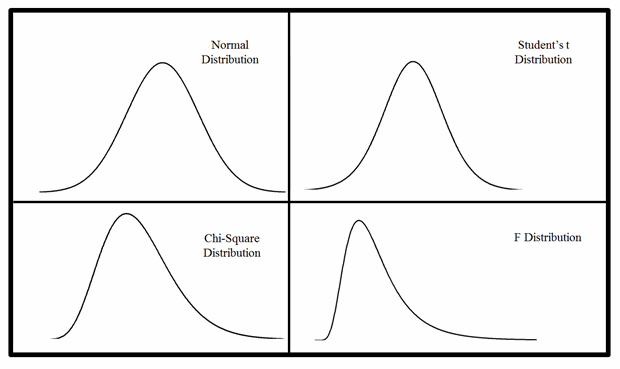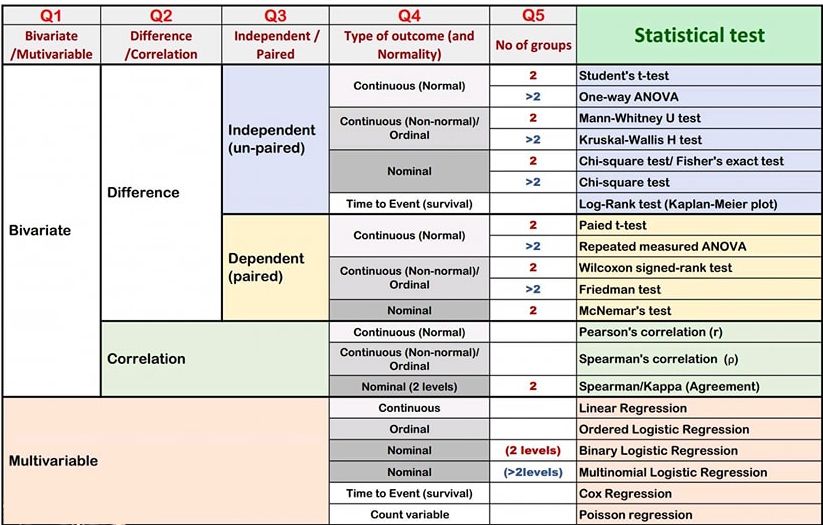DAiR Workshop 2024


Author: Dr. Hamed Abdollahi
PI: Dr. Homayoun Valafar
Section Goals:
 Gain an understanding of the dataset by performing initial exploration and cleaning
Gain an understanding of the dataset by performing initial exploration and cleaning
 Determine if the data follows a normal distribution
Determine if the data follows a normal distribution
 Measure the strength and direction of the relationship between two variables.
Measure the strength and direction of the relationship between two variables.
 Determine if there is a significant association between categorical variables (Chi-Square) and if there are differences between groups (T-Test)
Determine if there is a significant association between categorical variables (Chi-Square) and if there are differences between groups (T-Test)
 Apply appropriate tests based on the data distribution
Apply appropriate tests based on the data distribution
 Reduce the dimensionality of the dataset
Reduce the dimensionality of the dataset
Statistical Approach
The three main approaches in statistical modeling:
Frequentist
Approach to Probability: Uses the frequency or long-run proportion of events to describe probabilities.
Often considered more objective, suited for analyzing experiments.
Emphasizes rigorous, formal mathematical methods for analyzing and interpreting data.
Includes p-values and confidence intervals.
Bayesian
Bayesian statistics is an approach to data analysis and parameter estimation based on Bayes’ theorem:
\[ P(A∣B)=P(B∣A)P(A)⋅P(B) \]
where 𝐴 and 𝐵 are events and 𝑃(𝐵)≠0
Allows for the incorporation of prior knowledge and can be updated as new evidence becomes available.
More adaptable, suited for situations requiring subjective information or updating predictions with new data.
Also emphasizes rigorous mathematical methods, similar to the frequentist.
Machine learning:
Develops algorithms and computational tools to automatically identify patterns in data and make predictions based on those patterns.
Emphasizes practical, data-driven approaches where methods are evaluated based on their predictive performance on test datasets.
Less emphasis on theoretical properties compared to statistical inference; focuses more on empirical performance and scalability.
Data vs. Information
Information: Information is derived knowledge, obtained through various activities like measurement, analysis, observation, etc. One way to communicate and store information is by encoding it.
Data: Encoded information that is collected, captured, or measured.
Types of Encoded Information (Data)
Numeric Data:
Continuous Data: Can take any value within a range (e.g., temperature).
Count (Discrete) Data: Values are restricted to integers (e.g., number of people).
Categorical Data:
Ordered (Ordinal) Data: Categorical data with a predefined order (e.g., rating scales).
Unordered (Nominal) Data: Categorical data without a specific order (e.g., types of fruits).
Binary Data: Categorical data where the only possible values are 0 and 1, where an event is either a “hit” or a “miss”.
Methods of Data Collection
Observational Data:
- Collected by passive observation without intervention, based on what is seen or heard.
Experimental Data:
- Collected following a scientific method with a prescribed methodology, actively and deliberately. Often involves treatment and control groups in studies like clinical drug trials.
Data Structure
Structured Data: Organized in rows and columns, presenting a clear order and format for analysis.
Unstructured Data: Lacks a predefined structure and requires techniques to organize and prepare it for analysis.
Normal Distribution
- A type of data distribution where:
The mean equals the median.
Approximately 2/3 (68%) of the data lie within one standard deviation (SD) of the mean.About 95% of the data are within two standard deviations.
Roughly 97% of the data are within three standard deviations.
At 0, the mean equals the median, indicating a normally distributed data set.
Skewed Distribution
A type of data distribution where the median does not equal the mean.
Types:
Left-Skewed Distribution: Characterized by a long tail on the left side of the graph.
Right-Skewed Distribution: Characterized by a long tail on the right side of the graph.

The standard normal (z) distribution
The
pnorm( )function gives the area, or probability, below a z-value:A two-tailed test is used when you want to test if a sample mean is significantly different from a population mean in both directions.
The
qnorm( )function gives criticalz-valuescorresponding to a given lower-tailed area:
The t distribution
The pt( ) function gives the area, or probability, below a t-value. For example, the area below t=2.50 with 25 d.f. is
The qt( ) function gives critical t-values corresponding to a given lower-tailed area:
The chi-square distribution
The pchisq( ) function gives the lower tail area for a chi-square value:
Multidimensional Data:
A multidimensional data set is represented by a \(n \times d\) data matrix, which can also be visualized as a table with n rows and d columns.
\(\mathbf{x}_1, \mathbf{x}_2, \ldots, \mathbf{x}_n\) denote the n rows of the data matrix D.
Each \(\mathbf{x}_i\) (where i ranges from 1 to n) represents an individual observation or instance in the dataset.
Dataset:
The simplest form used in statistics and machine learning is tabular data.
A structured table of data where:
Rows: Each row represents a measured instance of associated information, often referred to as observations, records, tuples, or trials.
Columns: Each column lists specific pieces of information (features, fields, attributes, predictors, variables) organized under a common encoding for comparison across instances.
The data matrix D is structured as follows:
\[ D = \begin{bmatrix} x_{11} & x_{12} & \cdots & x_{1d} \\ x_{21} & x_{22} & \cdots & x_{2d} \\ \vdots & \vdots & \ddots & \vdots \\ x_{n1} & x_{n2} & \cdots & x_{nd} \end{bmatrix} \]
Where:
\(\vec{x}_i = [x_{i1}, x_{i2}, \ldots, x_{id}]\) represents the i-th observation.
Data Point:
- The intersection of an observation (row) and a feature (column) in a dataset, \(xij\).
Robust
- Refers to an estimate being less susceptible to outliers.
Regression
A method to analyze the impacts of independent variables on a dependent variable.
Types
- ANOVA and models are both types of regression analyses.
General Linear Model
Formulas representing the expected value of a response variable for given values of one or more predictors.
Typically represented as y=mx+b.
Use
lm()to construct these models.
Generalized Linear Model
Models that tweak the normal formula in one way or another to measure outcomes that general linear models can’t address, abbreviated as GLM.
Only logistic models will be used.
Use
glm()to construct these models.
Kurtosis
- Measures the size of the tails in a distribution.
Classical Statistics
Classical statistics covers essential topics that are central to data analysis, including:
Estimation: The process of inferring the value of a population parameter based on a sample.
Quantification of Uncertainty: Assessing the reliability and variability of estimates and predictions.
Hypothesis Testing: Evaluating hypotheses about population parameters based on sample data.
These topics form the foundation for analyzing data, making decisions, and drawing conclusions from data.
Estimate
A statistic calculated from your data.
Called an estimate because it approximates population-level values from sample data. It’s synonym is “Metric.”
library(palmerpenguins)
data<-penguins| Function | Description |
|---|---|
| abs(x) | Computes the absolute value |x|. |
| sqrt(x) | Computes the square root of x. |
| log(x) | Computes the logarithm of x with the natural number e as the base. |
| log(x, base = a) | Computes the logarithm of x with the number a as the base. |
| a^x | Computes a^x. |
| exp(x) | Computes e^x. |
| sin(x) | Computes sin(x). |
| sum(x) | When x is a vector x = (x1, x2, x3, ..., xn), computes the sum of the elements of x: sum(x) = sum(i=1 to n) xi. |
| prod(x) | When x is a vector x = (x1, x2, x3, ..., xn), computes the product of the elements of x: prod(x) = prod(i=1 to n) xi. |
| pi | A built-in variable with value π, the ratio of the circumference of a circle to its diameter. |
| x %% a | Computes x modulo a. |
| factorial(x) | Computes x!. |
| choose(n, k) | Computes n choose k (binomial coefficient). |
Hypothesis Testing and P-Values
Statistical hypothesis testing is used to determine which of two complementary hypotheses is true.
In statistics, a hypothesis is a statement about a parameter in a population, such as the population mean value.
Example Structure of a statement:
“If I [do this to the independent variable], then [this will happen to the dependent variable].”
The two hypotheses are:
1- Null Hypothesis (H0): This corresponds to “no effect,” “no difference,” or “no relationship.”
2- Alternative Hypothesis (H1): This corresponds to “there is an effect,” “there is a difference,” or “there is a relationship.”
Conducting the Hypothesis Test Formulate the Hypotheses:
1- Null Hypothesis \((H0): \triangle=0\)
The mean weight of apples in a farm is 150 grams.
- Notation: \(H_0: \mu = 150\)
2- Alternative Hypothesis \((H1): \triangle ≠ 0\)
The mean weight of apples in a farm is not 150 grams.
- Notation: \(H_a: \mu \neq 150\)
3- One-way Test (One-tailed Test)
A one-way test, or one-tailed test, considers the possibility of an effect in one direction only.
This type of test is used when you have a specific direction in which you expect the results to go.
Example: Testing if the mean weight of apples is greater than 150 grams.
Notation: \(H_a: \mu > 150\)
4- Two-way Test (Two-tailed Test)
A two-way test, or two-tailed test, considers the possibility of an effect in both directions.
This test is used when you do not have a specific direction for the effect and want to test for any difference.
Example: Testing if the mean weight of apples is different from 150 grams (could be either greater or less).
Notation: \(H_a: \mu \neq 150\)
5- Select the Significance Level \((\alpha)\):
- Alpha (α) is the probability of rejecting the null hypothesis (H0) when the alternative hypothesis (Ha) is true.
- Ranges 0 to 1.
- Common choices for \(\alpha\) are 0.05, 0.01, and 0.10.
4- Calculate the Test Statistic:
- Depending on the test, this could be a t-statistic, z-statistic, etc.
5- Determine the P-Value:
The p-value (frequentist statistics) is the probability of obtaining a test statistic at least as extreme as the one observed, assuming that the null hypothesis is true.
\(\binom{n}{r}=\frac {n!}{r!(n−r)!}\)
If the p-value is less than or equal to the significance level \(\alpha\), we reject the null hypothesis.
The purpose of hypothesis testing is to determine which of the two hypotheses to believe in.
The null hypothesis won’t be rejected unless there is compelling evidence against it.
Types of Errors:
Type I Error: Rejecting \(H0\) when it is true (false positive). The probability of committing a Type I error is \(\alpha\).
Type II Error: Failing to reject \(H0\) when \(H1\) is true (false negative).
Lower \(\alpha\) reduces the risk of Type I errors but increases the risk of Type II errors.
- Higher \(\alpha\) increases the risk of Type I errors but decreases the risk of Type II errors.
A common choice is to use \(\alpha = 0.05\) as the cut-off, meaning that the null hypothesis is falsely rejected in 5% of all studies where it is, in fact, true, or that 1 study in 20 finds statistical evidence for alternative hypotheses that are false.
Tests and Models
Types of Statistical Tests
Parametric: Applicable to normal distributions.
Used to compare means of groups.
- Student’s t-test
Paired Student’s t-test
Analysis of Variance (ANOVA) Test
Repeated Measures ANOVA Test
Applied to samples with normally distributed numeric data.
Utilize the actual values of the variable.
Non-Parametric: Applicable to any distribution.
Used to compare medians of groups.
- Mann-Whitney U Test
Wilcoxon Signed-Rank Test
Kruskal-Wallis H Test
Friedman Test
Applied to samples with non-normally distributed numeric data or ordinal data.
Utilize the ranks of the values.
Correlation test
Correlation measures how closely related two variables are. It is suitable to studying the association between two variables.
A positive value close to 1 indicates a strong positive linear relationship (as one variable increases, the other tends to increase).
A value close to 0 indicates no linear relationship.
A negative value close to -1 indicates a strong negative linear relationship (as one variable increases, the other tends to decrease).
- Pearson’s Test: Assumes data follows a normal distribution and calculates linear correlation.
Spearman’s Test: Does not require normality; evaluates non-linear correlation.
Kendall’s Test: Also does not require normality; assesses non-linear correlation and is more robust. However, it is more complex to compute manually and is less commonly used.
CHi-Square test
A statistical test used to determine if there is a relationship between two categorical variables.
Null Hypothesis: Assumes that the variables are independent of each other.
Comparing Tests: Results from different tests cannot be directly compared; Kendall’s correlation coefficients typically range 20-40% lower than Spearman’s.
Bivariate Analysis
Involves two variables.
Aims to determine the relationship or association between the two variables.
Independent (Unpaired) Data:
Observations in each sample are not related.
No relationship exists between the subjects in each sample.
Characteristics:
Subjects in the first group cannot also be in the second group.
No subject in either group can influence subjects in the other group.
No group can influence the other group.
Dependent (Paired) Data:
Paired samples include:
Pre-test/post-test samples (a variable is measured before and after an intervention).
Cross-over trials.
Matched samples.
When a variable is measured twice or more on the same individual.
Multivariate Analysis
Involves more than two variables.
Aims to understand how multiple factors simultaneously impact an outcome.
Uses regression models to quantify the effect of each variable while controlling for the others.

t-Test
A statistical method used to compare the means of two groups.
If your group variable has more than two levels, it’s not appropriate to use a t-test; instead, use an ANOVA (Analysis of Variance).
Types of t-test
One Sample T-test:
Compares the mean of a sample to a known value (population mean).
Used when comparing the mean of a sample to a known value (population mean).
Paired T-test (Dependent T-test):
Compares the means of two related groups (e.g., before and after treatment).
Used when comparing the means of two related groups (e.g., before and after treatment).
Unpaired T-test (Independent T-test):
Compares the means of two independent groups.
Student’s T-test:
Used when the variance in both groups is assumed to be equal.
Also known as the Equal Variance T-test or Two Sample T-test.
Used when the sample sizes and variances of the two groups are assumed to be equal.
Welch T-test:
Used when the variance in the two groups is assumed to be unequal.
Also known as the Unequal Variance T-test or Welch’s T-test.
Used when the sample sizes and variances of the two groups are different.
Chi-Square test
Test of Independence
Test of Association
It is a non-parametric test used to determine if there is a relationship between two categorical variables.
The null hypothesis states that no relationship exists between the variables (they are independent).
It compares categorical variables and cannot be used to compare numerical variables.
It indicates whether the two variables are dependent or independent but does not specify the type of relationship between them.
There must be a
Contingency Tablewhich:Has at least two rows and two columns (2x2).
Is used to present categorical data in terms of frequency counts.
Two Categorical Variables: Each variable should have at least two groups (e.g., Gender with groups Female and Male).
Independence of Observations: There should be independence both between and within subjects in the data.
Large Sample Size: This ensures the validity of the test results.
Expected Frequencies: Each cell in the contingency table should ideally have an expected frequency of at least 1.
Majority of Cells: At least 80% of the cells should have expected frequencies of at least 5.
Correlation test
Correlation tests are used to measure the strength and direction of relationships between variables. Here are the key points:
Correlation quantifies whether greater values of one variable correspond to greater values of another variable. It is scaled between +1 and -1:
Positive Correlation: Values increase together.
Negative Correlation: One value decreases as the other increases.
Zero Correlation: No apparent link between the values.
Correlation Methods
Pearson’s Test: Assumes normal distribution and measures linear correlation between continuous variables.
Spearman’s Test: Non-parametric test that does not assume normality; measures non-linear correlation, suitable for continuous or ordinal variables.
Kendall’s Test: Non-parametric test similar to Spearman’s, also measures non-linear correlation but less commonly used.
Differences Between Pearson’s and Spearman’s Tests
Pearson’s Test Spearman’s Test Type Parametric Non-parametric Relationship Linear Non-linear Variables Continuous Continuous or ordinal Sensitivity Proportional change Change not at constant rate
ANOVA
ANOVA (Analysis of Variance) is a statistical test used to compare the means of three or more groups of data. Here are the key points:
Types of ANOVA
One-way ANOVA
Compares the means of three or more groups based on a single independent variable (or factor).
Requires at least three observations within each group.
Two-way ANOVA
Compares the means of three or more groups considering two independent variables (or factors).
Evaluates how each variable individually and together affect the dependent variable.
Assumptions
Independence: Observations within each sample are independent and identically distributed (iid).
Normality: Data in each sample follows a normal distribution.
Equal Variance: Variances across all samples are equal.
Interpretation
Null Hypothesis (H0): Assumes all group means are equal.
Alternative Hypothesis (H1): States that at least one group mean is different from others.
After determining that there are differences among the samples, pairwise comparisons must be conducted to identify which specific groups differ from each other.
As the number of comparisons increases, the probability of a false positive (Type I error) increases dramatically (e.g., 90% probability with α = 0.05).
Post-hoc tests address this issue by adjusting the significance level (α) to maintain an overall desired level of significance across multiple comparisons.
Common post-hoc tests include:
Tukey HSD: Compares all possible pairs of groups to each other.
Dunnett: Compares treatment groups with a control group.
Bonferroni Correction: Divides the desired global α level by the number of comparisons (α’ = α / number of comparisons).
Kruskal-Wallis test
The Kruskal-Wallis test is utilized to compare three or more groups based on a quantitative variable, extending the Mann-Whitney test, which compares two groups under non-normality assumptions.
Null Hypothesis (H0): The three penguin species have equal bill lengths.
Alternative Hypothesis (H1): At least one species differs in bill length from the other two species.
It’s important to note that rejecting the null hypothesis does not imply that all species differ in flipper length; it means at least one species differs from the others.
The Kruskal-Wallis test requires a quantitative dependent variable (bill length) and a qualitative independent variable (penguin species with at least three levels).
It is a nonparametric test, hence it does not assume normality.
The observations must be independence groups.
Equality of variances is not required for comparing groups but is necessary if comparing medians directly.
It’s essential to identify which specific group(s) differ from the others using post-hoc tests, also known as multiple pairwise-comparison tests, which conducted after obtaining significant results from the Kruskal-Wallis test.
Common post-hoc tests following a significant Kruskal-Wallis test include:
Dunn test
Conover test
Nemenyi test
Pairwise Wilcoxon test
